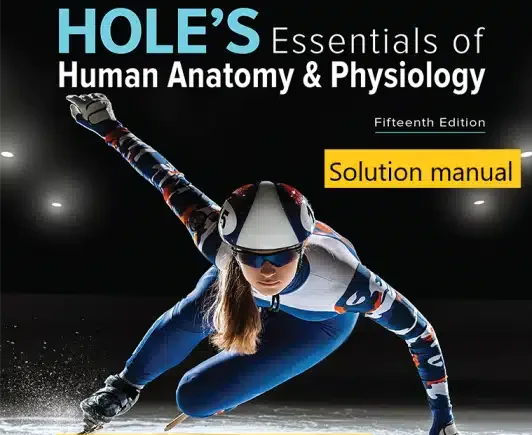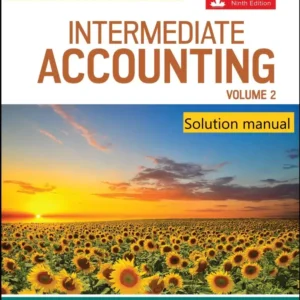Original price was: $39.99.$24.99Current price is: $24.99.
Solution manual for Hole’s Essentials of Human Anatomy & Physiology 15th Edition By Charles Welsh
Product ID: 0923200
For Contact: bookzon.shop@gmail.com
Description
Solution Manual for Hole’s Essentials of Human Anatomy & Physiology, 15th Edition
By Charles Welsh
Product Overview
The Solution Manual for Hole’s Essentials of Human Anatomy & Physiology, 15th Edition by Charles Welsh is an essential resource for students enrolled in one-semester anatomy and physiology courses. This edition is designed for students with no prior science background, providing an accessible and thorough introduction to key concepts in human anatomy and physiology. The textbook integrates clinical applications throughout, making complex topics more relatable and understandable for students pursuing careers in the allied health field.
The Learn, Practice, and Assess system is a core feature of the textbook and its accompanying digital content. This effective learning system ensures students engage with the material through the following steps:
-
Learning: Clear learning outcomes at the beginning of each chapter to guide students on what they will master.
-
Practice: Practice questions at the end of each section to reinforce what students have learned.
-
Assess: End-of-chapter resources that help students test their understanding and confirm their retention of key concepts.
This structured approach promotes active learning, ensuring students gain a deep understanding of anatomy and physiology.
Key Features of the 15th Edition
1. Designed for Allied Health Students
This textbook is specifically crafted for students studying in the allied health field, making difficult scientific concepts easier to grasp and directly applicable to real-world healthcare situations.
2. Comprehensive Learning System
The Learn, Practice, and Assess system is designed to enhance the learning experience. It allows students to actively engage with the material, practicing their knowledge and then assessing their understanding.
-
Learning Outcomes: Each chapter begins with clear objectives, helping students focus on key concepts.
-
Practice Questions: Section-ending questions ensure students reinforce their learning before moving on.
-
Assessments: End-of-chapter assessments allow students to check their comprehension and solidify their understanding.
3. No Prior Science Knowledge Required
The 15th Edition assumes no prior science knowledge, making it ideal for students starting their studies in human anatomy and physiology. Its accessible language ensures that all students, regardless of their background, can understand and master the material.
4. Clinical Applications
Throughout the text, students will find clinical applications that connect theoretical concepts to real-world healthcare settings. These examples help students understand the practical importance of the material they are learning, particularly for careers in fields such as nursing, physical therapy, and medical sciences.
5. Updated Content for Modern Healthcare
The 15th edition includes the latest anatomical and physiological research, ensuring students are learning the most up-to-date information. The content remains highly relevant for students pursuing careers in healthcare and medical sciences.
Table of Contents
UNIT 1: LEVELS OF ORGANIZATION
-
Chapter 1: Introduction to Human Anatomy and Physiology
Provides foundational knowledge about human anatomy and physiology, setting the stage for the topics covered in the rest of the book. -
Chapter 2: Chemical Basis of Life
Explains the biochemistry of life, covering topics such as atoms, molecules, and chemical reactions that are essential for maintaining life. -
Chapter 3: Cells
Introduces the basic cell structure and the functions of various cell organelles, explaining their roles in maintaining bodily functions. -
Chapter 4: Cellular Metabolism
Focuses on how cells produce and use energy, detailing the processes involved in metabolism and energy transfer. -
Chapter 5: Tissues
Describes the four basic types of tissues in the human body: epithelial, connective, muscle, and nervous tissue.
UNIT 2: SUPPORT AND MOVEMENT
-
Chapter 6: Integumentary System
Explains the structure and function of the skin, hair, and nails, emphasizing their protective roles. -
Chapter 7: Skeletal System
Focuses on the bones, joints, and the structure of the skeletal system, discussing their role in movement and protection. -
Chapter 8: Muscular System
Covers the structure and function of muscle tissue, including skeletal muscles, and their role in movement and posture.
UNIT 3: INTEGRATION AND COORDINATION
-
Chapter 9: Nervous System
Discusses the brain, spinal cord, and nerves, and how the nervous system controls and coordinates bodily functions. -
Chapter 10: The Senses
Covers the sensory systems, including vision, hearing, taste, smell, and touch, and their role in perceiving environmental stimuli. -
Chapter 11: Endocrine System
Introduces the hormonal system, covering the glands and hormones that regulate various body functions.
UNIT 4: TRANSPORT
-
Chapter 12: Blood
Explains the components of blood, its role in oxygen transport, and its involvement in immune defense. -
Chapter 13: Cardiovascular System
Focuses on the heart, blood vessels, and circulatory system, detailing how they transport blood and nutrients throughout the body. -
Chapter 14: Lymphatic System and Immunity
Describes the lymphatic system and the immune system, covering how they defend the body against pathogens.
UNIT 5: ABSORPTION AND EXCRETION
-
Chapter 15: Digestive System and Nutrition
Explains how the digestive system processes food, absorbs nutrients, and supports overall health. -
Chapter 16: Respiratory System
Covers the lungs and airways, focusing on how the respiratory system facilitates gas exchange and maintains oxygen levels. -
Chapter 17: Urinary System
Explains the role of the kidneys and urinary system in removing waste and regulating fluid balance. -
Chapter 18: Water, Electrolyte, and Acid-Base Balance
Discusses how the body maintains the balance of water, electrolytes, and acid-base levels.
UNIT 6: THE HUMAN LIFE CYCLE
-
Chapter 19: Reproductive Systems
Focuses on the male and female reproductive systems, explaining how they function in reproduction. -
Chapter 20: Pregnancy, Growth, Development, and Genetics
Covers the stages of human development and the role of genetics in growth and inheritance.
For more solutions, click here.







Well organized
Great choice
Excellent printing
Comfortable learning
Matches the exam